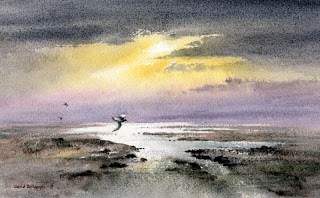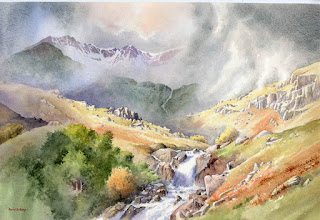I love exploring quiet estuaries, well away from the hubub of modern life, where all you may hear is the haunting cry of the occasional curlew, and to sit sketching the scene as twilight begins can be a memorable experience. Often at such times the colours are reduced and it is easier to get a moody effect, though having to work quickly before darkness descends can induce mistakes. I generally begin with a few quick photographs of the scene at a variety of exposure settings, and then launch into the sketch. Photographs are helpful to back up your sketches and having several at different exposures where there is a strong lighting contrast will give you a better chance of producing a result that is closer to what you actually see with the eye.

In this watercolour I have added birds, with the closer one acting as the centre of interest. A hint of sparkle on the water was achieved by drybrushing a light grey wash across the central areas. The large white parts are simply white paper, but where I went too far with the paint I have scratched out highlights with a scalpel, mainly to the right of the white water. The paper is Saunders Waterford High White, Rough 300lb
This painting, with several others is now on show at Beaulieu Fine Arts, in Beaulieu High Street on the edge of the New Forest, postcode SO42 7YA. See www.beauliefinearts.co.uk or telephone 01590 612089
The painting is also featured in my new book, Seas & Shorelines in Watercolour, which is doing extremely well, and even those who have no intention of painting the sea will benefit, as it includes a wide variety of skies, buildings, rocks, cliffs, figures and birds, as well as some exquisite daubs of mud! For more information see my website. Now that summer is here I hope you are all getting out with your paints – make the most of it.




